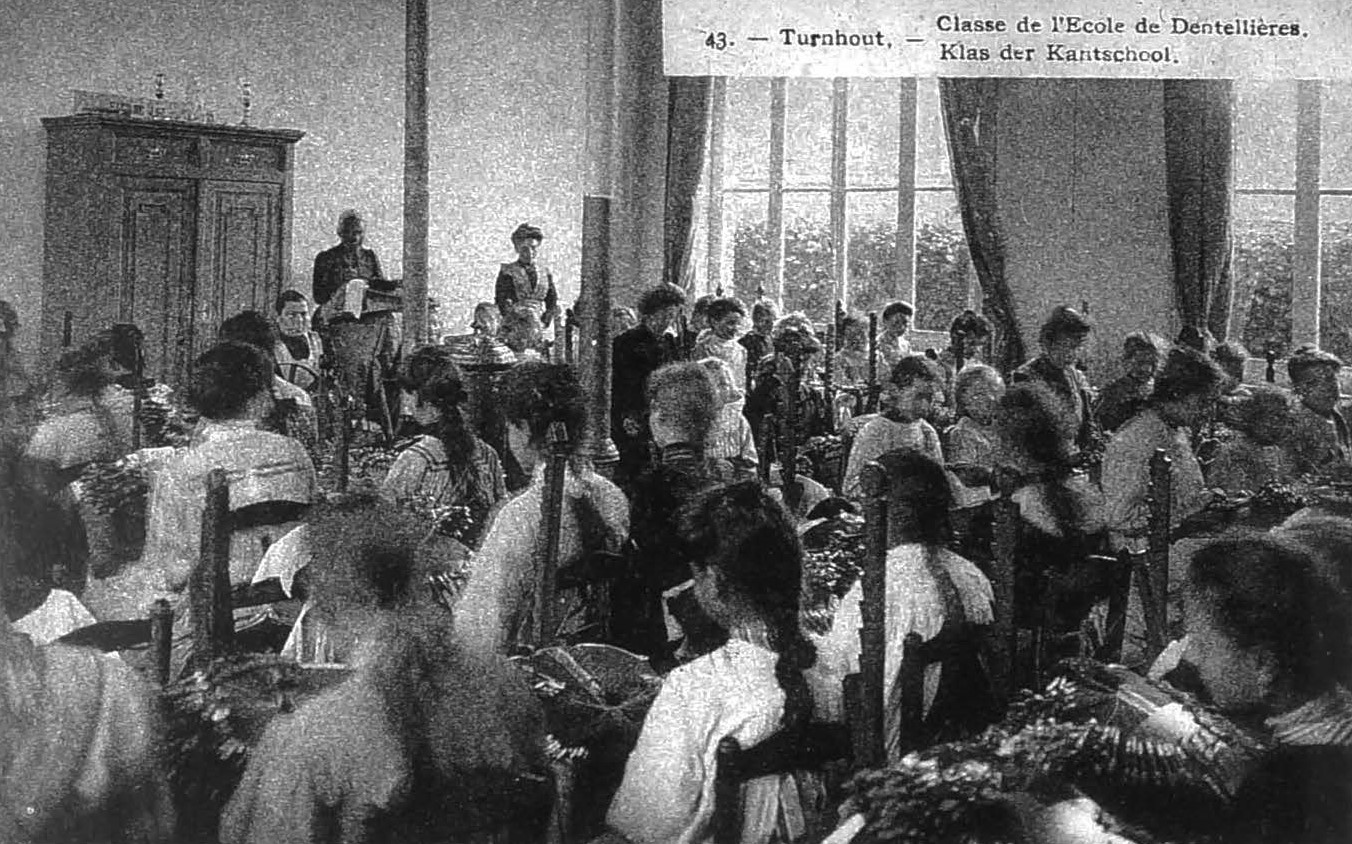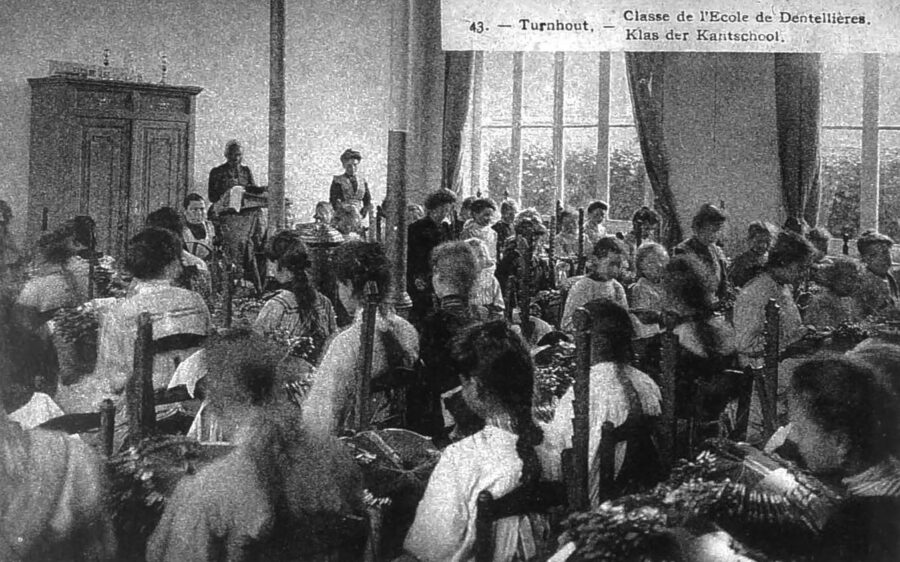
‘The Miracle of the Snows’. Late C15, probably Flemish painting.
A very belated post for the Feast of Our Lady of the Snows, which fell on 5 August. One of the Virgin Mary’s many titles, her legend is set in 4th century Rome, where a couple wanted to leave their fortune to the Virgin but had not decided how it should be spent. At the height of summer, snow fell on the Esquiline Hill, and this miracle was taken as a sign that a church should be built there – what is now the Basilica of St Mary Major. Until the fifteenth century Our Lady of the Snows was a largely Roman cult, but during the Counter-Reformation it spread across the Catholic world.
Our Lady of the Snows was much celebrated by lacemakers. Some Bruges lacemakers said a daily prayer to her to keep their lace snow-white, as money would be deducted from their earnings if their lace was tarnished.[1] (Historically lacemakers had several ways of making their lace as white as snow; some, such as the use of white lead, were incredibly damaging to their health.) Lacemakers in the same city carried a gift of lace to the statue of Our Lady of the Snows in Bruges cathedral on her feast day.[2] Brussels lacemakers had done the same until her chapel was pulled down during the French occupation of the city.[3] However, we only know of two places where she was the patron of lacemakers: Almagro in central Spain – to which we hope to return – and Turnhout on the Belgian border with the Netherlands, which is our focus today.

The model lace school in the Klinkstraat, Turnhout, founded in 1910. Old Postcard.
Unlike other Flemish centres, the lace industry in Turnhout seems to have thrived into the first decades of the twentieth century. According to the American visitor Charlotte Kellogg, half the female population of the city were involved in the trade, including 1,800 girls and young women enrolled in the numerous lace schools.[4] The largest of these were the religious institutions run by the Sisters of the Sacred Heart and the Sisters of the Holy Sepulchre, as well as the model school established in 1910 by Father Berraly, but there were also many smaller, private institutions with 30 to 50 lace apprentices. Turnhout lacemakers graduated from the supposedly easier ‘Engelsche grond’ (point de Paris) to ‘halve slag’ (point de Lille) to the extremely fine and very expensive ‘Ijsgrond’ (point de Malines). Perhaps it was this specialism in difficult laces that kept the handmade lace business buoyant in the region. A Dutch socialist newspaper in 1910 complained that the women workers earned only 9-10 francs a week for 70-80 hours work, but compared with salaries in other centres in the west of Belgium this was comparatively high.[5] The trainees in the lace schools earned much less, of course. None the less, lacemakers in Turnhout had a strong sense of their own skill and worth, which found expression in their songs and in their patronal feastday celebrations.[6]

A lace school working in the open air. Turnhout postcard
As we’ve seen in previous posts about Saint Gregory’s in Geraardsbergen and Klein-Sacramentsdag in Ypres, the feastday celebrations were led by the lace schools rather than lacemakers more generally – indeed in Turnhout the day was named ‘domineeren’, that is the teachers’ holiday (akin to ‘dominie’ in Scots). On the morning of the Saturday nearest to 5 August, the lace apprentices, in costumes covered with ribbons and paper streamers, formed rows behind a ceremonial arch likewise decorated with paper flowers and coloured, blown eggshells, from which was suspended a life-size effigy of a lacemaker at her pillow. Each school, led by its mistress, then marched through the city, ‘singing, skipping, laughing and chattering’ as they went according to one witness, towards one of the numerous chapels and wayside shrines nearby. The most popular was the chapel of Our Lady of the Snows (Onze Lieve Vrouw ter Sneeuw) in Oosthoven.

The chapel of Onze-Lieve-Vrouw ter Sneeuw in Oosthoven, near Turnhout
Here is one of the songs the lacemakers sang on their way:
| Den dag is nu al aangekomen, Den dag van O.L.V. Ter Sneeuw, Hoe zullen wij dezen dag nu vieren, Den dag dat wij nu feest genieten. |
The day has now arrived, The day of Our Lady of the Snows, How shall we celebrate this day, This day on which we enjoy a party. |
| Refrein: Het is maar voor de jonge jeugd, De feest die wij nu vieren, Dan roepen wij met een blij gemoed, Dan gaan wij naar den doolhof toe. |
Chorus: It’s only for the young, The feast that we’re now celebrating, Then we’ll shout with an eager heart, Then we’ll go to ‘the Maze’ (a wilderness area near Oosthoven) |
| Als wij in den doolhof zijn gekomen, Wat zullen wij dan eens gaan doen, Wij zullen ons eigen goed gedragen, En ons Meesteressen geerne zien. |
As we come to the Maze, What shall we do there, We shall do ourselves some good, And our mistresses see with pleasure. |

Some schools visited the chapel of Onze-Lieve-Vrouw van Troost in Lokeren instead
After a brief ceremony at the chapel, where the lacemakers prayed to Our Lady of the Snows that their lace should always remain white, the group travelled on to one of the nearby country inns, such as ‘De Vrat’ which features in one song. Here the mistress stood the workers a drink – beer for the older girls, sage milk for the younger – and many ‘mastellen’, a local type of cinnamon bun (which also is named in a song).

Mastellen in the oven. Eaten ‘without number’ by lacemakers on the feastday of Our Lady of the Snows
In return the lacemakers toasted their mistresses:
| Vivat onze Meesteressen, Zij hebben voor ons zooveel gedaan, Zij hebben ons slagjes leeren maken, En onze handjes laten gaan. |
Long live our mistresses, They have done so much for us, They have taught us how to make stitches, And let loose our hands. |
| Refrein: En zullen wij dan eens schoon palleeren, En onze geldekens daaraan geven, Als wij den druk der scholen zien, Hoe wij de feest van de werksters zien. |
Chorus: And then we shall doll ourselves up, And spend our money, As we see the schools busy, That’s how we see the workers’ feastday. |
| Engelsche grond willen wij niet werken, Dat is voor ons veel te gemijn, Dat is maar voor de kleine kinderen, Die eerst op ‘t werken gekomen zijn. |
We don’t want to make ‘Point de Paris’, That’s too base for us, That’s more for the small children, That’s the first work they do. |
| Wij kunnen allerhande kanten werken, Zoowel ijsgrond als halve slag, En daar een bloemeke in zetten, Zoowel een rooske als eenen tak. |
We can make all kinds of lace, ‘Point de Malines’ as much as ‘Point de Lille’ And set a flower in it, A rose as easily as a sprig. |
| Wij hebben den naaam dat wij zijn lui werksters, Wel lieve vrienden het is niet waar, En komt dan Zaterdag’s eens kijken, Of dat er een zonder cent zal gaan. |
People say we’re lazy workers, But friends that’s just not true, Just come and have a look on Saturday, Whether any of us is penniless. |
But while the lacemakers celebrated their skill, as we have seen on other Flemish holidays they could also express frustrations with the demands the work placed upon them:
| Een en dertig, twee en dertig, drij, vier, vijf, zes, zeven en dertig! Toujours,toujours En mijnen boutenbak, mijnen boutenbak! Toujours, toujours, En mijnen boutenbak viel op den vloer! |
One and thirty, two and thirty, Three, four, five, six, seven and thirty! Still, still And my bobbin-case, my bobbin-case! Still, still, My bobbin-case lies on the floor! |
| Ongeneerd zoo zullen wij wezen, ongeneerd zoo zullen wij zijn! Laat ons, laat ons vreugde rapen, vreugde rapen; Laat ons, laat ons vreugde rapen al onder ons! |
Unabashed we shall become, Unabashed we shall be, Let us, let us Gather pleasure, gather pleasure: Let us, let us Gather pleasure among us! |
On the journey back to the city, the various schools taunted each other:
| Al de scholen gaan te niet, uitgenomen, uitgenomen, al de scholen gaan te niet, uitgenomen Lis Verwilt’es niet! |
All the schools are rubbish, Except, except, All the schools are rubbish, Except Lis Verwilt’s, that’s not! |
But before they went home, there was one last symbolic act: the lacemakers’ burnt their festive arch and their lacemaker guy – a reprensentation of their teacher? – in a field, while singing:
| En wij hebben onzen boog verspeld in Oosthoven, in Oosthoven! En wij hebben onzen boog verspeld in Oosthoven, op het veld! |
And we’ve thrown away our arch In Oosthoven, in Oosthoven! And we’ve thrown away our arch In Oosthoven, on the field! |
| En wij hebben onzen boog verbrand in Oosthoven, in Oosthoven! En wij hebben onzen boog verbrand in Oosthoven, op het veld! |
And we’ve burnt our arch In Oosthoven, in Oosthoven! And we’ve burnt our arch In Oosthoven, on the field! |
Most of these songs were first collected by Canon Jozef Jansen, a priest and also later Turnhout’s archivist. He noted that the custom was already moribund in 1910. However, when another priest-cum-local historian Jozef Nuyts wrote an account of the feastday in 1939, he could still find living witnesses to tell him about it, while the radio producer Pol Heyns was able to record schoolchilden in Turnhout singing several of the songs. Links to these recordings are provided here:
‘Een-en-dertig, twee-en-dertig’
‘En we hebben een boog besteld’

Pol Heyns (top right) on his radio car, from which he recorded songs all over Flanders. From the website https://schrijversgewijs.be/schrijvers/heyns-pol/
[1] M[agda] C[afmeyer], ‘Leerschool en spellewerkschool te St.-Kruis’, ‘t Beertje (1969): 20-48, 34.
[2] Rond den Heerd 5, no. 36 (July 1870): p. 282 ‘Dagwijzer’. This cult is mentioned in Guido Gezelle’s poem ‘Spellewerkend zie ‘k u geerne’, to which we dedicated a previous post.
[3] Baron Otto von Reinsberg-Düringsfeld, Traditions et légendes de la Belgique: Descriptions des fêtes religieuses et civiles, usages, croyances et pratiques populaires des Belges anciens et modernes (Brussels, 1870), vol. 2, p. 74.
[4] Charlotte Kellogg, Bobbins of Belgium (New York, 1920), chap. 1.
[5] ‘Iets over huisarbeid’, De Proletarische Vrouw, 1 October 1910, p. 2.
[6] Most of the information in this post comes from two articles in the local historical journal: Jozef Jansen, ‘De kantvervaardiging in Turnhout: Haar geschiedenis en bewerking’, Taxandria 8 (1911), p. 117- 82; Jozef Nuyts, ‘Het Domineeren der Turnhoutsche Kantwerksters’, Annuaire de la Commission de la vieille chanson populaire (1939): 119-33. A special issue of the journal Taxandria was dedicated to the Turnhout lace industry in 2003.







